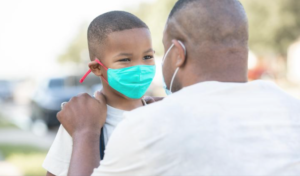
This article was published In Charlotte Business Journal website by By Kristi Pikiewicz Ph.D. Registered Psychotherapist
Resilience is an oft sought-after word these days. Seemingly everywhere we turn, there is some measure of forces bearing down upon us, increasing stress, anxiety, and depression. This reality is all too often exasperated in the lives of our children. So many of us have watched as the influences of these last seven months have warped the present and the future for our kids, and we often wonder what can be done to ensure a measure of success and hope. At Thompson Child and Family Focus, we encounter and endure this truth every day, in every child and family we serve. We collaborate and work with many tremendously talented individuals who are endlessly working to preserve the mental state and reliance of our children and our lives.
Kristi Pikiewics, Ph.D. is a wonderful example of one of these heroes. In this piece, she takes the time to discuss how we can use the pandemic to build resilience in the next generation. The conversation here is full of ways for us to turn a negative situation into something that can unlock a more resilient and stronger future. – Justin Ellis, vice president of development, Thompson Child & Family Focus
As a school psychologist, I see the pandemic’s effects on kids firsthand. The fear, the worry, the uncertainty, the upheaval to their lives – it’s comparable to many other kinds of trauma like a car crash or serious medical diagnosis.
And like these other kinds of trauma, there are a couple possible outcomes. One road leads to posttraumatic stress disorder, which could look like anxiety in crowds years from now once the pandemic is long gone (knock on wood). But another road leads to something psychologists call posttraumatic growth, which is a kind of wisdom and resilience that grows from struggle. As kids have returned to school this fall in multiple forms, we have the opportunity as parents and professionals to use the pandemic as a disruption that sparks growth.
Much of my own work has been in guiding this posttraumatic growth, often with parents of chronically ill children, but the strategies are applicable to the pandemic, as well. And because one of my personal struggles with the pandemic is the feeling of powerlessness – as if we’re being tossed on the waves of forces beyond our control – I wanted to offer some concrete things we can do to help kids emerge from this storm stronger than they were at its outset.
While kids and families are unique, here are the strategies I’m recommending to parents and guardians in my personal and professional circles this year.
It’s impossible to keep kids in the dark
Oh, how I wish we could protect our kids from the world. Up to a certain age, it has certainly been my strategy to withhold news of terror events like school shootings. But even young kids sense change in the air, like animals scenting a forest fire. And for the vast majority of kids, it’s worse living under the cloud of some unnamed dread than it is to face the pandemic head-on. As much as possible (and in an age-appropriate way), try to help kids understand the real health, economic and social impacts of the pandemic.
Help kids put language to their feelings
I often work with families who describe their relief at finally getting a definite medical diagnosis, even when that diagnosis is scary. Finally, they have a name for the condition creating symptoms, and along with the name often come concrete steps to address it. I see a similar dynamic in the pandemic, in which kids are experiencing the “symptoms” of challenging emotions, but lack language to express how they feel.
Are they scared or confused or angry or depressed or disappointed? By helping a child name these feelings, we open the door to doing something about it, for example, confusion could be addressed by more information and feeling disappointed about things like online learning or the inability to see friends could be addressed with special activities and creative ways to socialize.
A little suffering is OK
When a psychologist works with a patient, the relationship naturally goes through cycles of “rupture and repair.” Actually, this is the same in any relationship, be it with a partner, co-worker, sibling or friend. Eventually, something happens to create friction, but working through periods of challenge shows the relationship is strong enough to handle friction.
As parents, our impulse is to make everything perfect for our kids, all the time. But allowing them to struggle a bit helps a child see their own strength – what fun would a game a Chutes and Ladders be without the chutes? Within reason, we can apply this approach to the pandemic, as well.
Social distancing is difficult; online learning is hard; many of us can’t afford the things we once could; meanwhile, it seems like dishes are piling up in the sink and carboard boxes from online pandemic shopping are piling up in the driveway. To a degree, we can ask our kids to join us in the daily struggle to keep the train on the tracks, and by doing so, they can learn their strength as individuals and also see that when you pull together as a family, you can deal with challenges.
Connection matters
As parents and guardians, we have a lot on our plates right now – so what’s another two hours of Minecraft? Sometimes you need to use screen time as a babysitter so you can do that important Zoom call. And when there’s no other option, don’t beat yourself up about it. We’re all doing the best we can. But when you come up for air, help your kids come up for air, too.
One thing that all studies of resilience show is that social connections matter. Help your kids connect with friends, teachers, extended family, and most of all, with you. Believe me, I know this can be hard: As much as you love your kids, by the time you’ve spent all day in the same house, you’re ready for a break. At that point, forget about setting up activities for your kids that they love but you hate. It’s just not going to happen. But try to find something you both enjoy, maybe cooking or a puzzle or even sitting together while you read. Or, because older adults may be especially isolated right now, find a way for your kids to play a card game with grandparents or older friends via Zoom. (Better yet, have grandparents help your kids with their homework.) No matter what form it takes, help your kids connect with real people.
It’s hard right now. It’s hard for adults and it’s hard for kids. But difficult doesn’t have to mean disastrous. In fact, difficulty can be a tool – an opportunity to connect with a core of strength and resilience. Years from now Covid-19 will be a strange and awful year in the history books. But your child’s understanding of their own resilience will last a lifetime.
The right tools can help
Let’s face it, kids and teens crave screentime on their devices. If you can’t get your kids to do offline activities, then try digital tools that have a positive impact, allow them to work through the hard stuff that comes their way while immersed in a game, for example. Tools like Shadow’s Edge can be valuable in helping young people take an active role in their emotional health and help them build the skills to take what they learn in the game and about themselves from the virtual world in to their real world.
The Digging Deep Project is a nonprofit organization that helps young people build resilience through digital tools like their free mobile game Shadow’s Edge. Find out more about the Digging Deep Project at www.diggingdeep.org and download the free game at https://bit.ly/shadowsedgegame.
Kristi Pikiewicz, Ph.D., is a registered psychotherapist and offers individual, couples and family therapy to adults, adolescents and children, and psychological testing and assessments. She is a Postdoc Fellow at the Boulder Institute for Psychotherapy and Research. Pikiewicz provides psychological guidance to the development of the game Shadow’s Edge.
